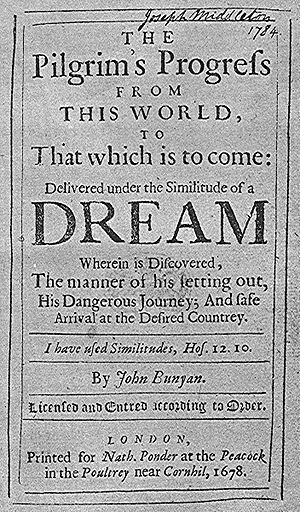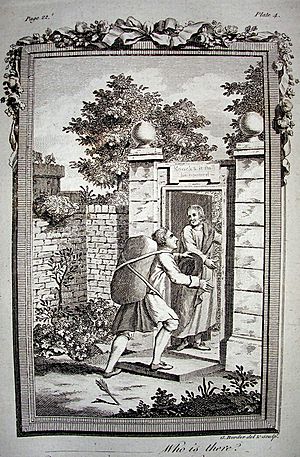The Pilgrim's Progress facts for kids
The Pilgrim's Progress is a famous English book by John Bunyan. It came out in two parts: the first in 1678 and the second in 1684. Its full name is The Pilgrim's Progress from this World to that which is to come. Many people think it's one of the most important books in English literature. It's a special kind of story called an allegory.
The book tells a dream story about a journey through the English countryside. Bunyan uses this journey to share ideas about Christianity. Even though the journey is made up, the places are based on real spots in Bedfordshire from the 1600s. The main character, Christian, faces many challenges. These challenges are like the difficulties a Christian person might face in life. John Bunyan was put in jail for sharing his ideas. But after the book was published, it was translated into over 200 languages!
Contents
How the Book Was Written
John Bunyan started writing The Pilgrim's Progress while he was in jail. He got into trouble for preaching without a special permit called a licence. At that time, only ministers from the Church of England were allowed to preach. Bunyan was a Baptist, so he didn't qualify for a licence.
He spent 12 years in Bedford jail. He could have been set free if he promised not to preach, but he refused. He was finally released when the law changed in 1672. He was jailed again for a short time in 1677.
The book has two parts and is quite long. Each part is a continuous story without chapter breaks. When the first part came out in 1678, it quickly became very popular. Part Two was published in 1684. During John Bunyan's lifetime, the first part had 11 different printings, and the second part had two.
What is an Allegory?
An allegory is a story where the characters and events represent deeper meanings or ideas. In The Pilgrim's Progress, the main character, Christian, goes on a journey and meets many interesting people. Christian is like an "everyman" character. He represents any ordinary person, including the reader. His journey is a symbol for the journey of a good Christian's life.
Many of the places Bunyan describes are based on real places he knew in the Bedfordshire countryside. For example, the 'Slough of Despond' is thought to be the marshes in Tempsford. 'House Beautiful' might be Houghton House, which is now a ruin. The character called the 'Evangelist' is based on Bunyan's friend, John Gifford.
Christian carries a heavy burden on his back. This burden represents his sins, or the wrong things he has done. It also reminds us that Bunyan used to work as a tinker. A tinker mends pots and pans and often carried a heavy anvil on his back.
Later in the story, the 'Land of Beulah' is like Middlesex County. The 'Very Deep River' is like the Thames. And the 'Celestial City' represents London.
The Story's Journey
Part One: Christian's Adventure
Part One tells the story of a man named Christian. He travels from the 'City of Destruction' (which means Earth) to the 'Celestial City' (which means Heaven). Christian feels weighed down by a big burden after reading a book, which is like the Bible. He wonders how he can be saved. A character named Evangelist appears many times to guide him. Evangelist shows Christian the way to the 'Wicket Gate'. Christian tries to get his family to come along, but they say no, so he leaves alone.
The first person he meets is Mr. Worldly Wiseman. This man tells Christian he can be saved by following the law. He suggests Mr. Legality can help him. But Evangelist stops Christian from going that way. He reminds Christian that he must go to the Wicket Gate.
At the Wicket Gate, the gatekeeper, Goodwill, tells Christian to stay on the straight path. In the second part of the book, Goodwill is shown to be Jesus himself. Christian asks about getting rid of his burden. Goodwill tells him to go to the 'place of deliverance'.
Christian then visits the House of the Interpreter. Here, he sees pictures that explain ideas about the Christian faith. After this, he reaches the 'place of deliverance'. This place is like the hill where Jesus died on the cross. There, his heavy burden falls off his back, and he feels very relieved. Three shining figures greet him with peace. They give him new clothes and a special passport to the Celestial City. This part is like a Christian Baptism.
At the top of the 'Hill of Difficulty', Christian stops at the 'House Beautiful'. This house represents a local Christian congregation. Christian stays there for three days. When he leaves, he wears armour. This armour protects him when he fights a monster called Apollyon. Then he goes to the 'Shadow of Death'. He isn't afraid because his friend Faithful reminds him of words from Psalm 23: "Yea, though I walk through the valley of the shadow of death, I will fear no evil: for thou art with me; thy rod and thy staff they comfort me." The sun rises as he leaves this valley.
Just outside the Valley of the Shadow of Death, Christian meets Faithful. Faithful also used to live in the City of Destruction. They travel together to 'Vanity Fair'. There, they are both arrested. They don't like the greedy business happening at the fair. Faithful is put on trial and then executed. Hopeful, who lives in Vanity, takes Faithful's place as Christian's friend for the rest of the journey.
Christian and Hopeful have many adventures together. They are captured by Giant Despair. He takes them to 'Doubting Castle', where they are jailed, beaten, and starved. Suddenly, Christian remembers he has a key called Promise. This key can open all the doors and gates of Doubting Castle. Using the key, they escape.
They come to the 'Delectable Mountains'. Here, shepherds show them wonderful sights of a place called 'Immanuel's Land'.
On their way, Christian and Hopeful meet a man named Ignorance. Ignorance believes he can enter the Celestial City even though he doesn't truly believe. A ferryman called Vain Hope takes Ignorance across the River of Death. But Ignorance is turned away from the gates of the Celestial City and thrown into hell.
Christian and Hopeful finally reach the Celestial City.
Part Two: Christiana's Journey
The Second Part of The Pilgrim's Progress tells the story of Christian's wife, Christiana. Their sons and a young woman named Mercy also join her. They visit the same places Christian did, but their journey takes longer. This is because the story includes the marriage of Christian's sons. It also includes the children born to the four sons and their wives.
This part of the story shows that women can be just as brave as men. They visit the same stops Christian did. However, their journey is longer because they marry and have children along the way. The hero of this part is Greatheart. He is a servant of the Interpreter and guides the pilgrims to the Celestial City. Greatheart kills four giants, including Giant Despair. He also helps defeat a monster that scares the city of Vanity.
Part Two shows how human beings can be weak. It includes women, children, and people who are not strong in body or mind. When Christiana's group leaves Gaius's Inn, Mr. Feeble-mind wants to be left behind. But Greatheart encourages him to come along:
"But brother ... I have it in commission, to comfort the feeble-minded, and to support the weak. You must needs go along with us; we will wait for you, we will lend you our help, we will deny ourselves of some things, both opinionative and practical, for your sake; we will not enter into doubtful disputations before you, we will be made all things to you, rather than you shall be left behind."
Images for kids
-
William Blake: Christian Reading in His Book (Plate 2, 1824–27)
See also
 In Spanish: El progreso del peregrino para niños
In Spanish: El progreso del peregrino para niños










